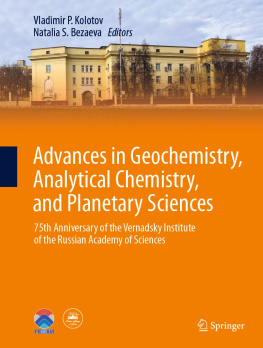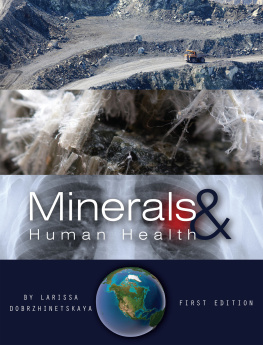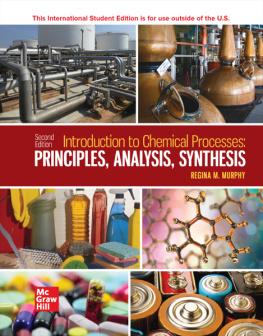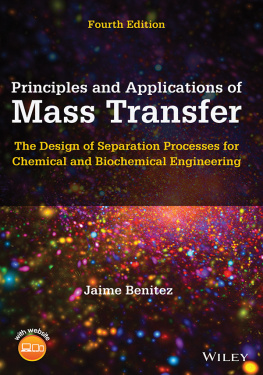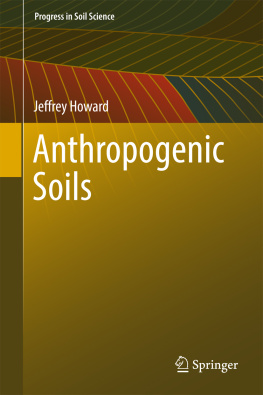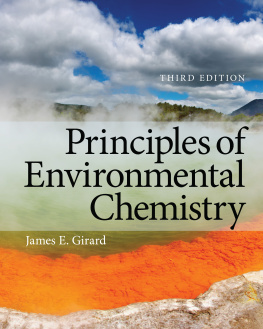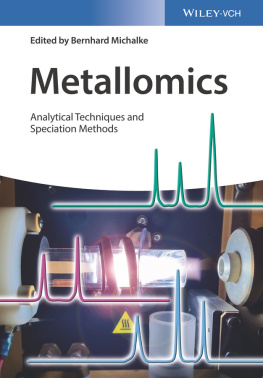
Table of Contents
List of Tables
- Chapter 1
- Chapter 2
- Chapter 3
- Chapter 4
- Chapter 5
- Chapter 6
- Chapter 7
- Chapter 8
- Chapter 9
- Chapter 10
- Chapter 11
List of Illustrations
- Chapter 1
- Chapter 2
- Chapter 3
- Chapter 4
- Chapter 5
- Chapter 6
- Chapter 7
- Chapter 8
- Chapter 9
- Chapter 10
- Chapter 11
Guide
Pages
Environmental and LowTemperature Geochemistry
Second Edition
Peter Ryan
Middlebury College, Middlebury, VT, USA, 05753

Copyright
This second edition first published 2020
2020 John Wiley & Sons Ltd
Edition history
Wiley Blackwell Ltd (1e, 2014)
All rights reserved. No part of this publication may be reproduced, stored in a retrieval system, or transmitted, in any form or by any means, electronic, mechanical, photocopying, recording or otherwise, except as permitted by law. Advice on how to obtain permission to reuse material from this title is available at http://www.wiley.com/go/permissions.
The right of Peter Ryan to be identified as the author of this work has been asserted in accordance with law.
Registered Office(s)
John Wiley & Sons, Inc., 111 River Street, Hoboken, NJ 07030, USA
John Wiley & Sons Ltd, The Atrium, Southern Gate, Chichester, West Sussex, PO19 8SQ, UK
Editorial Office
9600 Garsington Road, Oxford, OX4 2DQ, UK
For details of our global editorial offices, customer services, and more information about Wiley products visit us at www.wiley.com.
Wiley also publishes its books in a variety of electronic formats and by printondemand. Some content that appears in standard print versions of this book may not be available in other formats.
Limit of Liability/Disclaimer of Warranty
While the publisher and authors have used their best efforts in preparing this work, they make no representations or warranties with respect to the accuracy or completeness of the contents of this work and specifically disclaim all warranties, including without limitation any implied warranties of merchantability or fitness for a particular purpose. No warranty may be created or extended by sales representatives, written sales materials or promotional statements for this work. The fact that an organization, website, or product is referred to in this work as a citation and/or potential source of further information does not mean that the publisher and authors endorse the information or services the organization, website, or product may provide or recommendations it may make. This work is sold with the understanding that the publisher is not engaged in rendering professional services. The advice and strategies contained herein may not be suitable for your situation. You should consult with a specialist where appropriate. Further, readers should be aware that websites listed in this work may have changed or disappeared between when this work was written and when it is read. Neither the publisher nor authors shall be liable for any loss of profit or any other commercial damages, including but not limited to special, incidental, consequential, or other damages.
Library of Congress CataloginginPublication Data
Names: Ryan, Peter Crowley, 1966- author.
Title: Environmental and lowtemperature geochemistry / Peter Ryan
(Middlebury College, Middlebury, VT, USA).
Description: 2nd edition. | Hoboken, NJ : Wiley-Blackwell, 2019. | Includes
index. |
Identifiers: LCCN 2019016029 (print) | LCCN 2019018347 (ebook) | ISBN
9781119568629 (Adobe PDF) | ISBN 9781119568612 (ePub) | ISBN 9781119568582
(pbk.)
Subjects: LCSH: Environmental geochemistry--Textbooks. |
Geochemistry--Textbooks.
Classification: LCC QE516.4 (ebook) | LCC QE516.4 .R93 2019 (print) | DDC
551.9--dc23
LC record available at https://lccn.loc.gov/2019016029
Cover Design: Wiley
Cover Image: Peter Ryan
Preface
The title Environmental and LowTemperature Geochemistry seeks to encompass the scope of this text, from topics commonly covered in traditional geologybased geochemistry texts as well as those in environmental chemistry and aqueous geochemistry texts. The lowtemperature part indicates a focus on Earth surface systems (< 50C for most topics covered) rather than metamorphic or igneous environments, although information from these highertemperature systems is also considered in some sections. The target audience is upperlevel undergraduates and graduate students, as well as professionals in geology and environmental science. The goal is to explain basic concepts from biogeochemistry and geology as they apply to understanding and predicting behavior of natural and anthropogenic constituents in systems at and near the surface of the Earth. The importance of the geological record of environmental change informs our understanding of the natural environment and improves our ability to predict system behavior, so sediment (and glacier) records of paleoclimate and environmental change are presented and examined. Increasing knowledge of the role of organisms from microbes to macroscale plants in inorganic and organic geochemistry is reflected in examples of biomineralization, microbial mediation of reactions, influence of root exudates, and more.
The scope ranges from the atmosphere and oceans to streams, lakes, groundwater, soils, sediments, and shallow crust. It also spans global and regionalscale systems to pore spaces and nanoparticles. Understanding complex environmental systems requires factual, conceptual, and quantitative skills, so this book attempts to provide the background needed to objectively assess problems and questions through the lens of geochemistry. Inspiration for different sections comes from many excellent geochemistry and environmental chemistry texts, particularly those of Berner and Berner, Drever, Eby, Faure, Langmuir, Moore and Reynolds, Spiro and Stigliani, and Walther. The wellworn copies on my bookshelf attest to their influence on my understanding of geochemistry and how to write a universitylevel textbook that also can serve as a reference for earth and environmental scientists.
contains an introductory presentation of relevant principles from organic chemistry then focuses on structure, composition, environmental behavior, consequences, and remediation of organic contaminants.
(carbonates and the C cycle) and 6 (N, P, and S cycles), with a systems approach that conceptually and quantitatively examines reservoirs, fluxes, and processes, from inorganic to microbially affected.
, including oxygen chemistry and the role of free radicals, reactions involved in the formation and destruction of pollutants, the photochemical smog cycle, and origin and deposition of acid rain.
explores various topics, including: quantifying element mobility and how to apply it to paleoclimate analysis; thermodynamics and construction of mineral stability diagrams (and the utility of them); the geochemistry of the soil forming factors, soil profiles, and soil orders; how soils influence ecosystem response to acid rain; plant nutrients; toxic metals and metalloids; saline soils; and organic contaminants in soils.
.
Throughout the second edition of
Next page


